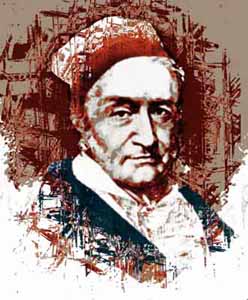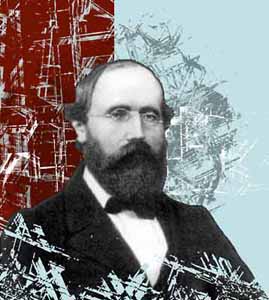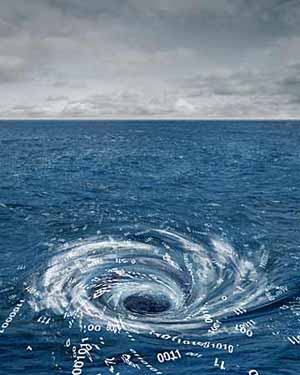
A whirlpool of numbers
Jeserac sat motionless within a whirlpool of numbers. The first thousand primes, expressed in the binary scale that had been used for all arithmetical operations since electronic computers were invented, marched in order before him. Endless ranks of 1's and 0's paraded past, bringing before Jeserac's eyes the complete sequences of all those numbers that possessed no factors except themselves and unity. There was a mystery about the primes that had always fascinated Man, and they held his imagination still.Jeserac was no mathematician, though sometimes he liked to believe he was. All he could do was to search among the infinite array of primes for special relationships and rules which more talented men might incorporate in general laws. He could find how numbers behaved, but he could not explain why. It was his pleasure to hack his way through the arithmetical jungle and sometimes he discovered wonders that more skilful explorers had missed.
He set up the matrix of all possible integers, and started his computer stringing the primes across its surface as beads might be arranged at the intersections of a mesh. Jeserac had done this a hundred times before and it had never taught him anything. But he was fascinated by the way in which the numbers he was studying were scattered, apparently according to no laws, across the spectrum of the integers. He knew the laws of distribution that had already been discovered, but always hoped to discover more.
from The City and the Stars by Arthur C. Clarke (1956)
The building blocks of arithmetic

Carl Friedrich Gauss
In the words of the great German mathematician Carl Friedrich Gauss: "Mathematics is the Queen of the Sciences and Arithmetic is the Queen of Mathematics." The modern name for the branch of mathematics that Gauss was referring to as Arithmetic is Number Theory - the study of the properties of the positive whole numbers or integers. The 19th century mathematician Kronecker famously claimed that "God made the integers, all the rest is the work of man."
The fundamental building blocks of Number Theory are the primes. These are the numbers: 2, 3, 5, 7, 11, 13,... defined as the whole numbers that cannot be divided exactly by any other whole number, excluding the trivial division by the number 1. Primes cannot be broken down into simpler components; they play a role in mathematics that is similar to the role of the elements in chemistry. From the 100 or so chemical elements it is possible to synthesize the millions of compounds that are studied by chemists. The Fundamental Theorem of Arithmetic, which was proved by Euclid, states that
All positive whole numbers are either primes or they can be uniquely decomposed into a product of primes.For instance:
\begin{eqnarray*} 84 &=& 2 \times 2 \times3 \times7,\\ 85 &=& 5 \times17,\\ 86 &=& 2 \times43,\\ 87 &=& 3 \times29,\\ 88 &=& 2 \times2 \times2 \times11,\\ 89 & &\mbox{ is prime},\\ 90 &=& 2 \times3 \times3 \times5,\\ 91 &=& 7 \times13 \end{eqnarray*}
If we take all the primes less than 300, we find that there are just 62 of them:
2, 3, 5, 7, 11, 13, 17, 19, 23, 29,
31, 37, 41, 43, 47, 53, 59, 61, 67, 71
73, 79, 83, 89, 97, 101, 103, 107, 109, 113,
127, 131, 137, 139, 149, 151, 157, 163, 167, 173,
179, 181, 191, 193, 197, 199, 211, 223, 227, 229,
233, 239, 241, 251, 257, 263, 269, 271, 277, 281,
283, 293.
25 of these primes are below 100, 21 are between 100 and 200 and 16 are between 200 and 300. It looks as though the primes become more spread out as their size increases. If we look further we find that between 10,000 and 10,100 there are just 11 primes, between 100,000 and 100,100 there are just 6. This seems to confirm that the primes become rarer as they become bigger, but do they eventually die out altogether? We know that there are no naturally occurring elements on Earth beyond number 92 - Uranium. But is the same true of the primes? What is the biggest prime number?
There is no biggest prime
The properties of prime numbers have been studied by mathematicians since antiquity. It was the Ancient Greeks who first proved that there are infinitely many primes, so there is not, in fact, a biggest prime number. Euclid's {\em Elements} provides the oldest known proof. The proof works by showing that if we assume that there is a biggest prime number, then there is a contradiction. We can number all the primes in ascending order, so that $P_1 = 2$, $P_2 = 3$, $P_3 = 5$ and so on. If we assume that there are just $n$ primes, then the biggest prime will be labelled $P_n$ . Now we can form the number $Q$ by multiplying together all these primes and adding 1, so $$Q = (P_1 \times P_2 \times P_3 \times P_4... \times P_{n}) + 1.$$ Now we can see that if we divide $Q$ by any of our $n$ primes there is always a remainder of 1, so $Q$ is not divisible by any of the primes. But we know that all positive integers are either primes or can be decomposed into a product of primes. This means that either $Q$ must be prime or $Q$ must be divisible by primes that are larger than $P_n$. Our assumption that $P_n$ is the biggest prime has led us to a contradiction, this assumption must therefore be false, so there is no biggest prime.
How are primes distributed?
We now know that the primes become sparser as they become bigger, but they don't dwindle away completely. So the next question is, can we understand how the primes are distributed? Can the primes be fitted into a pattern in the way that the elements can be organised in the Periodic Table? This is one of the most important problems in the whole of mathematics.The spacing between primes seems quite irregular, but there does appear to be a tendency for the spacing to increase, as we noted above. The Prime Number Theorem states that the function $x/\ln(x)$, where $\ln(x$) is the natural logarithm of $x$, gives a reasonable approximation for the number of primes less than $x$, which we will represent as $\pi(x)$. As $x$ increases, this approximation becomes ever more accurate. The following table compares these two functions:
| x | Pi(x) | x/ln(x) | Pi(x)/(xln(x)) |
| 1000 | 168 | 145 | 1.159 |
| 10,000 | 1,229 | 1086 | 1.132 |
| 100,000 | 9,592 | 8,686 | 1.104 |
| 1,000,000 | 78,498 | 72,382 | 1.084 |
| 10,000,000 | 664,579 | 620,420 | 1.071 |
| 100,000,000 | 5,761,455 | 5,428,681 | 1.061 |
There is no simple formula that will generate all the primes, but Euler showed that the formula $$f(n) = n^2 - n + 41$$
is remarkable because it is equal to a prime for every integer value of $n$ up to 40. The primes generated by the formula are:
41, 43, 47, 53, 61, 71, 83, 97, 113, 131,
151, 173, 197, 223, 251, 281, 313, 347, 383, 421,
461, 503, 547, 593, 641, 691, 743, 797, 853, 911,
971, 1033, 1097, 1163, 1231, 1301, 1373, 1447, 1523, 1601.
The formula necessarily fails to produce a prime when $n = 41$, because in this case $f(n) = n^2 = 41^2$. \par Euler also devised a much more important function that is now known as the {\em zeta function}:
$$\zeta(s) = \Sigma (1/n^s) = 1^{-s} + 2^{-s} + 3^{-s} + 4^{-s} +...$$ Euler showed that the zeta function is equal to an infinite product $$z(s) = \Pi\frac{1}{(1 - 1/p^s)} = \frac{1}{(1 - 1/2^s)(1 - 1/3^s)(1 - 1/5^s)(1 - 1/7^s)...},$$ where the product is over all the primes $p$. This is a remarkable result: when the zeta function is expressed as the sum of an infinite number of terms,
the sum includes a term that takes a value for every positive integer, but when expressed as an infinite product the only terms that are included are those that take a value for a prime. \par The zeta function, as defined by Euler, is only valid for values of $s$ that are greater than 1. For these values of $s$ the zeta function can be summed to a finite value, even though the number of terms is
infinite. However, if $s$ is equal to or less than 1, the series diverges, so the function is not well defined. For instance, taking $s = -2$ gives $$ \Sigma(1/n^{-2}) = \Sigma n^2 = 1 + 4 + 9 + 16 + ...,$$ a series which increases without end. By comparison, when $s = 2$, $$\zeta(2) = \Sigma (1/n^2) = 1^{-2} + 2^{-2} + 3^{-2} + 4^{-2} + .... = 1 + 1/4 + 1/9 + 1/16 + .... $$ This series can be
summed to give $\zeta(2) = \pi^2/6$.
The Riemann Zeta Function

Georg Friedrich Bernhard Riemann
In 1859 Georg Friedrich Bernhard Riemann published his only paper on Number Theory. In this paper Riemann found a function that is identical to Euler's zeta function for values of $s$ that are greater than 1, but that is well defined for all real numbers. The Riemann zeta function is actually defined for {\bf complex values} of $s$, where $s=a+bi$ and $i^2=-1$. Riemann proved that there were many deep connections between his analytically continued zeta function and the distribution of primes. Riemann's intuition was quite remarkable in connecting the properties of a continuous function of a complex variable to the properties of the primes which are real and discrete. More specifically, Riemann showed that $\pi(x)$, the number of primes less than $x$, is related to the points at which the zeta function is equal to zero - these points are known as the {\em zeroes of the function}. Riemann found that when $s$ is a real number the zeta function only equals zero when $s$ is equal to a negative even integer, that is at the points $s = -2, -4, -6,...$ But Riemann also found other zeroes of the zeta function, all of which appeared to be on the line $s = 1/2 + bi$. The approximate value for the first of these is at $b = 14.134725$. Riemann conjectured that all the non-real zeroes of the zeta function lie on the line $s=1/2+bi$, although he was unable to prove this. The conjecture has become known as the {\em Riemann Hypothesis} and it is the key to understanding the distribution of the primes. Recent computer-based calculations have shown that at least the first 100 billion zeroes, with non-real $s$, all fall on Riemann's line. But, as yet, there is still no proof that there are no exceptions to this pattern.
The British number theorist G.H. Hardy relates in his book "A mathematician's apology" that before setting out on his return voyage over the North Sea from Denmark in the 1920s, expecting the crossing to be treacherous, he posted a note to a colleague to say that he had proved the Riemann Hypothesis. Although a staunch and proselytizing atheist, Hardy explained that he had sent the note in order to guarantee that God would not allow him to drown. Because if he had drowned that would mean that proofs had been claimed for both of the two most famous problems in mathematics: Fermat's Last Theorem and the Riemann Hypothesis, but that the mathematician making the claim had died before communicating the proof to anyone else. Fermat's Last Theorem had achieved legendary status amongst mathematicians, because, in the 17th century, the French civil servant and amateur mathematician Pierre de Fermat, one of the greatest figures in the history of Number Theory, had scribbled in the margin of a book that he had a wonderful proof of the theorem, but the margin was too small for him to write it down. The book was a 17th century edition of the classic Greek text on Number Theory written in the first century A.D., Diophantus' Arithmetica. Fermat subsequently died, leaving mathematicians to search for 350 years for a proof of the theorem.
The hardest problem in all of mathematics?

Ulam's Prime number spiral
In the 150 years since Riemann's paper nobody has ever been able to prove or disprove his conjecture, but Fermat's Last Theorem was finally proved by Andrew Wiles in 1994. The Riemann Hypothesis is now the most famous outstanding problem in mathematics. But the Riemann Hypothesis has far more important consequences for mathematics than Fermat's Last Theorem. In fact, there are areas of mathematics that have been developed by mathematicians on the assumption that the Riemann Hypothesis is true. The Riemann Hypothesis also appears to be an even more difficult problem than Fermat's Last Theorem.
Any implicit regularity in the primes that is encoded in the zeta function has still not been explicitly deciphered. However, there is a much simpler pattern exhibited in the distribution of primes. In 1963 the Polish mathematician Stanislaw Ulam, who worked on the American nuclear programme, the Manhattan Project, during the Second World War was doodling abstractedly in the interval between
two seminars at a conference. He drew a grid of squares, then he wrote the number 1 at the centre of the grid and continued to write out the sequence of all the positive integers in ascending order spiralling out from the centre. Ulam noticed to his great surprise that when the integers were organised in this way, there was a tendency for the primes to be lined up along diagonal lines in the
grid. The result was so unexpected that a picture of the Prime Number Spiral was featured on the cover of the March 1964 issue of Scientific American which included an article by Martin Gardner about the spiral: "Mathematical Recreations: The Remarkable Lore of the Prime Number." Sci. Amer. 210, 120-128, March 1964.

Primes along the diagonal of a spiral
The picture above shows the spiral for the first 100,000 integers. The composite numbers are shown as black dots and the primes are shown as white dots. In the grid numerous long diagonal white lines can clearly be seen. If numbers other than 1 are taken as the starting number of the spiral, the general appearance of the grid is the same. No-one has come up with a clear explanation of why this should be the case. But it implies that there are long sequences of primes that can be generated by formulae such as f(n)=an2+bn+c, where a, b and c are integers.
If we start with the number 41 at the centre of the spiral, we find that the numbers on the diagonal form the sequence f(n)=n2-n+41, which is the formula discovered by Euler that takes prime values for all integer values of n up to 40.
In the illustration the number 41 is situated at the centre and the numbers continue in an anti-clockwise spiral. The squares of the grid that contain composite numbers are coloured yellow and the squares that contain primes are coloured white. The first 15 numbers generated by the formula f(n)=n2-n+41 appear along one of the main diagonals of the
square.

A whirlpool of numbers
Although Stanislaw Ulam is generally credited with the discovery of the Prime Number Spiral, it appears that Ulam might not have been the first person to make this discovery. Chapter 6 of Arthur C. Clarke's classic 1956 novel "The City and the Stars" opens with the hero Jeserac analysing a "whirlpool" of integers on his computer monitor and seeing the primes strung out "across its surface as beads might be arranged at the intersections of a mesh". It looks as though Arthur C. Clarke had already discovered the Prime Number Spiral seven years before it was found by Ulam. I recently asked Sir Arthur C. Clarke about the inspiration for his discussion of the primes in "The City and the Stars". He told me that
After half a century I have no idea what made me think of this. I never had a computer until 1970 when H.P. gave me HAL Jr (HP9001), the direct ancestor of the palmtop. But I was impressed by the unfinished Babbage machine, which I must have seen in the Science Museum soon after I moved to London in 1936.
Mathematicians study the properties of primes for their own intrinsic interest. But prime numbers also have modern scientific applications, especially in cryptography. The United States Government Intelligence Agency, the NSA, is the world's biggest employer of pure mathematicians. Whenever you make a transaction on the internet, such as a credit card purchase, the security of the transaction is ensured by the use of public key encryption using a method based on some subtle Number Theory devised by Ron Rivest, Adi Shamir and Len Adleman, also known as RSA. RSA encryption utilises a numerical key that is formed by multiplying together two very large primes. The security of the system is dependent on the difficulty of factorizing very large numbers. The number of steps that are necessary to factorize a large number using all known algorithms increases exponentially with the size of the number. This means that the cryptographer can always stay one step ahead of the computer. If computer processors become fast enough to factorize the 128 digit numbers that are used for encipherment, we can start to use 512 digit numbers. However, if a mathematician were to find a new more efficient factorization algorithm the security of our enciphered transactions might be under threat. Cryptographers feel safe, because, although leading mathematicians have searched for such an algorithm for many centuries none has ever been found.
Last year three Indian mathematicians - Prof. Manindra Agrawal and two of his graduate students, Neeraj Kayal and Nitin Saxena - published an algorithm for testing whether a number is prime or composite (see Prime time from Issue 22 of Plus). The algorithm employs quite elementary arithmetic and is stated by the authors in just 13 lines. The important new feature of the algorithm is that the time taken to test the primality of a number N increases polynomially with the size of N rather than exponentially. In fact, it increases as the twelfth power of N. Following this revelation, perhaps we shouldn't be too hasty to rule out the possibility that there is also a simple algorithm for factorization that has similarly been overlooked. Maybe cryptographers should be worried.
Further Reading
- The City and the Stars - Arthur C. Clarke (1956)
- Fermat's Last Theorem - Simon Singh (1997)
- Life, the Universe and Mathematics CD-ROM by Nick Mee (1998)
- The Code Book on CD-ROM by Simon Singh and Nick Mee (2002)
About this article

Nick Mee studied mathematics at the University of Cambridge, was Senior Wrangler in 1985 and went on to complete a Ph.D. with the title "Supersymmetric Quantum Mechanics and Geometry".
He recently developed The Code Book on CD-ROM with Simon Singh and is currently developing software for Connections in Space with Professor John Barrow, the Director of the Millennium Mathematics Project. Details about his other software projects are available at the Virtual Image website.
This article was written with the valuable help and inspiration of Sir Arthur C. Clarke, who is currently writing a novel entitled "The Last Theorem" about Fermat's Last Theorem.
Comments
Anonymous
In discussing the Riemann hypothesis, why does nobody mention that the non-trivial zeta evaluations are all terms in the cotangent series whose first term is 1/2 which seems to have been interpreted as being a critical line, submitted by Peter L. Griffiths.
Anonymous
Near the beginning of his 1859 paper Riemann incorrectly assumes that the complex variable s =1/2 +ti is a zeta power. Riemann fails to recognise that an expression containing an imaginary number such as 1/2 +ti cannot be a power unless the base is a log base such as e. The best known example of this is Cotes's formula cosu + isinu equals e^(iu) where it is not possible for e to be meanfully replaced by other values, also e^(1/2) X e^(iu) equals e^[(1/2) +iu]. This means that Riemann is badly wrong in applying as a power s= (1/2) +ti. It also means that practically all the arguments in his 1859 paper are fallacious. submitted by Peter L. Griffiths.
Anonymous
A possible approach to identifying primes could be to recognise Euler's discovery H(1-[1/2)(1-[2/3])(1-[4/5])(1-[6/7]) .....=1, where H is the harmonic series, 1+(1/2) +(1/3) ... There might be a mathematical relationship between H and the product of primes without continuing to infinity. submitted by Peter L. Griffiths.
Anonymous
Riemann's 1859 article starts off well by referring to two of Euler's brilliant creations, firstly the prime product formula equalling the Harmonic series whose fractions can be raised to any power, secondly the cotangent series generating the zeta evaluations where the powers are positive integers. However after this, Riemann introduces lots of incorrect relationships so that the final result is highly unreliable. The best way to study primes is to investigate composites which Riemann never mentions.
Anonymous
Near the beginning of his 1859 paper, Riemann incorrectly assumes that the complex variable s =(1/2) + ti is a zeta power. Riemann fails to recognise that an expression containing an imaginary number such as (1/2) +ti cannot be a power unless the base is a log base such as e. The best known example of this is Cotes's formula cosu + isinu equals e^(iu), where it is not possible for e to be replaced by other values, also e^(1/2) X e^(iu) equals e^[(1/2) +iu]. This means that Riemann is badly wrong in applying as a power s= (1/2) +ti. It also means that practically all the arguments in his 1859 paper are fallacious. submitted by Peter L. Griffiths.
Anonymous
Further to my comment of 26 November 2013, I now consider that it is possible for e to be replaced by other values but only because the general formula for any variable base n should be the constant n^(u/logn). When n equals e, log n will be clearly 1. The fact that n^(t/logn) has to be a constant particularly when applied to i that is n^(ti/logn) undermines virtually all the arguments in Riemann's 1859 paper. submitted by Peter L. Griffiths.
houston
Just wondering could there be a connection between the Riemann Hypothesis and Ulams Spiral? I worked out the math behind the spiral some time ago.. I can provide all you with simple document that reveals the structure and how to navigate it..
Peter L. Griffiths
Fermat's last Theorem has been proved in less than 300 words in the February 2017 issue of M500.